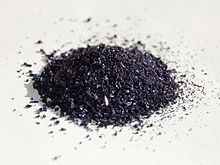|
Potassium permanganate (medical use)
Potassium permanganate is used as a medication for a number of skin conditions.[2] This includes fungal infections of the foot, impetigo, pemphigus, superficial wounds, dermatitis, and tropical ulcers.[3][2] For tropical ulcers it is used together with procaine benzylpenicillin.[2] [3] It can be applied as a soaked dressing or a bath.[2] Side effects may include irritation of the skin and discoloration of clothing.[2] If it is taken by mouth, toxicity and death may occur.[4] Potassium permanganate is an oxidizing agent.[5] The British National Formulary recommends that each 100 mg be dissolved in a liter of water before use.[3] Potassium permanganate was first made in the 1600s and came into common medical use at least as early as the 1800s.[6] It is on the World Health Organization's List of Essential Medicines.[7] Medical usesUses include for fungal infections of the foot, impetigo, pemphigus, superficial wounds, dermatitis (eczema), and tropical ulcers.[3][2] Typically it is used in skin conditions that produce a lot of liquid.[3] For tropical ulcers it is used together with procaine benzylpenicillin for two to four weeks.[2][8] It can be used in children and adults.[8] It can be applied as a soaked dressing or a bath.[2] Petroleum jelly may be used on the nails before soaking to prevent their discoloration.[1] The U.S. Food and Drug Administration does not recommend its use in either the crystal or tablet form.[9] Side effectsTopicalSide effects may include irritation of the skin and discoloration of clothing.[2] A harsh burn on a child from an undissolved tablet has been reported.[10] For treating eczema, it is recommended using for a few days at a time due to the possibility of it irritating the skin.[10] Higher concentration solutions can result in chemical burns.[11] Therefore, the British National Formulary recommends 100 mg be dissolved in a liter of water before use to form a 1:10,000 (0.01%) solution.[3][10] Wrapping the dressings soaked with potassium permanganate is not recommended.[8] By mouthIf taken by mouth it is toxic.[12] Side effects may include nausea, vomiting, and shortness of breath may occur.[13] If a sufficiently large amount (about 10 grams) is eaten death may occur.[4][13] Concentrated solutions when drunk have resulted in Acute Respiratory Distress Syndrome or swelling of the airway.[14] Recommended measures for those who have ingested potassium permanganate include gastroscopy.[14] Activated charcoal or medications to cause vomiting are not recommended.[14] While medications like ranitidine and N-acetylcysteine may be used in toxicity, evidence for this use is poor.[14] Mechanism of actionPotassium permanganate functions as an oxidising agent.[15] Through this mechanism it results in disinfection, astringent effects, and decreased smell.[15] HistoryPotassium permanganate was first made in the 1600s and came into common medical use at least as early as the 1800s.[6] During World War I Canadian soldiers were given potassium permanganate (to be applied mixed with an ointment) in an effort to prevent sexually transmitted infections (resulting mostly in violet stained genitals.)[16] Some have attempted to bring about an abortion by putting it in the vagina, though this is not effective.[17][18][19] Other historical uses have included as an effort to wash out the stomach in those with strychnine or picrotoxin poisoning.[20] Society and cultureIn the United States the FDA requires tablets of the medication to be sold by prescription.[9] Potassium permanganate, however, does not have FDA approved uses and therefore non medical grade potassium permanganate is sometimes used for medical use.[citation needed] It is available under a number of brand names including Permasol, Koi Med Tricho-Ex, and Kalii permanganas RFF.[21] It is occasionally called "Condy's crystals".[15] Other animalsPotassium permanganate may be used to prevent the spread of glanders among horses.[22] References
|
||||||||||||||||||||||||||||||||||||
Portal di Ensiklopedia Dunia
